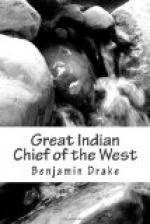1st) we found the
gentlemen [Indians] where
he stated he left them. As we neared them, they
raised a white flag, and endeavored to decoy us; but
we were a little too old for them; for instead of landing,
we ordered them to send a boat on board, which they
declined. After about fifteen minutes delay,
giving them time to remove a few of their women and
children, we let slip a six-pounder, loaded with canister,
followed by a severe fire of musketry; and if ever
you saw straight blankets, you would have seen them
there. I fought them at anchor most of the time
and we were all very much exposed. I have a ball
which came in close by where I was standing, and passed
through the bulkhead of the wheel room. We fought
them for about an hour or more until our wood began
to fail, and night coming on, we left and went on to
the prairie. This little fight cost them twenty-three
killed, and of course a great many wounded. We
never lost a man, and had but one man wounded, (shot
through the leg.) The next morning before we could
get back again, on account of a heavy fog, they had
the whole [of General Atkinson’s] army upon
them. We found them at it, walked in, and took
a hand ourselves. The first shot from the Warrior
laid out three. I can hardly tell you
any thing about it, for I am in great haste, as I am
now on my way to the field again. The army lost
eight or nine killed, and seventeen wounded, whom
we brought down. One died on deck last night.
We brought down thirty-six prisoners, women and children.
I tell you what,
Sam, there is no fun in fighting
Indians, particularly at this season, when the grass
is so very bright. Every man, and even my cabin-boy,
fought well. We had sixteen regulars, five rifle
men, and twenty of ourselves. Mr. How, of Platt,
Mr. James G. Soulard, and one of the Rolettes, were
with us and fought well.”
The flippant and vaunting style of this letter is
in good keeping with the spirit which prompted the
firing upon a flag of truce. By what circumstance
the commander of the Warrior ascertained that this
white flag was intended as a decoy, is left wholly
unexplained. As he and his men, were beyond the
reach of the Indians, humanity and the rules of war,
required that he should have allowed himself more than
fifteen minutes, to ascertain the true object
of the Indians, in raising the symbol of a capitulation.
Black Hawk himself, asserts that he directed his braves
not to fire upon the Warrior, as he intended going
on board in order to save the women and children;
that he raised a white flag and called to the captain
of the boat, desiring him to send his canoe on shore,
that he might go on board, as he wanted to give himself
up. The deplorable condition to which Black Hawk
was at this time reduced, flying for safety to the
west side of the Mississippi, encumbered by his women
and children, and his whole party exhausted by fatigue
and hunger, renders it extremely difficult to believe




